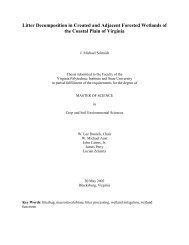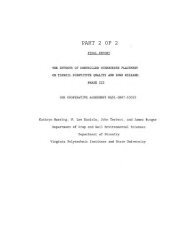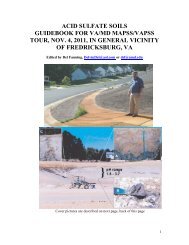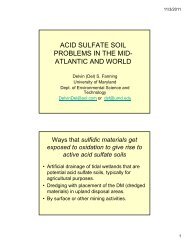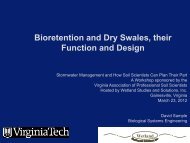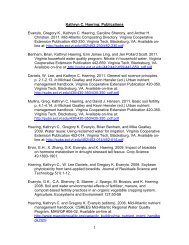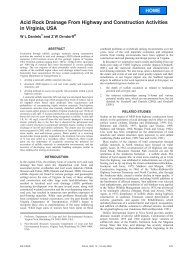Remediation of PAH-Contaminated Soils and Sediments: A ...
Remediation of PAH-Contaminated Soils and Sediments: A ...
Remediation of PAH-Contaminated Soils and Sediments: A ...
You also want an ePaper? Increase the reach of your titles
YUMPU automatically turns print PDFs into web optimized ePapers that Google loves.
Diffusion: Weber et al. (1992), Weber <strong>and</strong> Huang (1996), <strong>and</strong> Xing <strong>and</strong><br />
Pignatello (1997) have modeled the chain <strong>of</strong> events for <strong>PAH</strong> aging. As<br />
previously discussed, <strong>PAH</strong>s initially partition into <strong>and</strong> onto humic <strong>and</strong> fulvic acids<br />
(highly complex <strong>and</strong> stable forms <strong>of</strong> organic matter) followed by the diffusion into<br />
soil micropores. This second step in <strong>PAH</strong> aging <strong>and</strong> sequestration has been<br />
found to be further enhanced by the hydrophobic nature <strong>of</strong> both the interior wall<br />
<strong>of</strong> micropores <strong>and</strong> the <strong>PAH</strong>s (Nam <strong>and</strong> Alex<strong>and</strong>er, 1998b). Although part <strong>of</strong> this<br />
fraction can be extracted with harsh organic solvents, portions are still irreversibly<br />
bound (recalcitrant) <strong>and</strong> usually non extractable (Jones et al., 1996; Reid et al.,<br />
2000a).<br />
Some researchers feel that aging (through adsorption <strong>and</strong> diffusion) can reduce<br />
the bioavailability <strong>and</strong> toxicity <strong>of</strong> <strong>PAH</strong>s, so much that conventional extraction<br />
methods will overestimate risk (Kelsey et al., 1997; Alex<strong>and</strong>er, 2000; Macleod et<br />
al., 2001). The magnitude <strong>of</strong> the potential risk <strong>of</strong> recalcitrant fractions, however,<br />
is still a matter <strong>of</strong> debate (Semple et al., 2004). It has been shown that that<br />
organisms such as bacteria, earthworms, or plants are able to access these<br />
supposedly unavailable fractions by “facilitated desorption processes” (Park et<br />
al., 2001; Stokes et al., 2006) or diffusion back out <strong>of</strong> the micropore (Johnsen et<br />
al., 2005; Figure 9). Dissolved organic matter has also been shown to<br />
considerably increase water solubility <strong>of</strong> <strong>PAH</strong>s in contaminated soil (MacKay <strong>and</strong><br />
Gschwend, 2001), but bonding to humic substances have been found to reduce<br />
the toxicity <strong>of</strong> <strong>PAH</strong>s such as pyrene, fluoranthene, <strong>and</strong> anthracene (Perminova et<br />
al., 2001).<br />
Figure 9. Diffusion <strong>of</strong> entrapped <strong>PAH</strong> out <strong>of</strong> micropores to become available to<br />
bacteria (Johnsen et al., 2005). (Co-Cx) is the concentration gradient over<br />
distance x.<br />
Summary<br />
Polycyclic aromatic hydrocarbons are transferred, degraded <strong>and</strong> stored through a<br />
variety <strong>of</strong> mechanisms. These mechanisms contribute to the complexity <strong>of</strong><br />
research conducted with <strong>PAH</strong> contaminated soils <strong>and</strong> sediments. All processes<br />
(transfers, losses <strong>and</strong> persistence) must be considered when conducting<br />
experiments as well as during site remediation. A summary <strong>of</strong> the important<br />
processes is presented in Table 8.<br />
43



